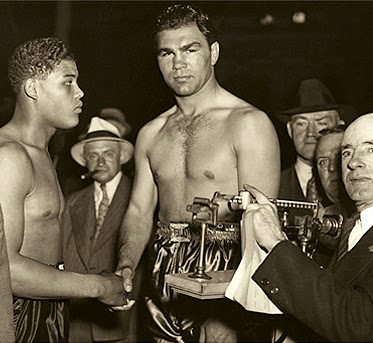The Fight of the Century!
(A premium seating ticket to the first Louis Schmelling fight)
The second matchup came on June 22, 1938; the results couldn't have been more different, Louis won by a knockout in 2 minutes and 4 seconds, Schmeling was only able to land two punches. Louis was the heavyweight champion of the world, and the master race had been delivered a KO.

Louis towers over his vanquished opponent.
Hitler made great overtures to Schmeling, all of which the fighter rebuffed. "I am no superman in any way" Schmeling said. Further, much to Hitler's displeasure, when Schmeling was fighting in the U.S. he refused to fire his Jewish promoter, Joe Jacobs.
With the outbreak of the Second World War, and Schmeling back home in Germany, he was drafted into the Luftwaffe and was accepted into the elite Fallschirmjager forces.
Schmeling on the cover of the German propaganda magazine Signal, wearing his m.38 fj helmet. Schmeling was in no way sympathetic to the Nazi cause, and post-war anecdotes have him sheltering two Jewish children at the beginning of the war.
Wounded in the assault on Crete Schmeling was medically discharged and spent the remainder of the war participating in morale-raising exhibition bouts.
---
Joe Louis however, was a willing volunteer, joining the US Army early in the war. In a highly publicized meeting with the president of the United States, Franklin D. Roosevelt is credited with saying to the "Brown Bomber"; "Joe, we need muscles like yours to defeat Germany."
Louis spent the entirety of the war assigned to US Army Special Services where he participated in exhibition fights to raise morale and boost sales of War Bonds.
In a period of racial discrimination and so-called white supremacy, Louis was able to win over many whites with his whole-hearted support of the war effort and his much-reprinted and much quoted statement; "...we'll win because we're on God's side."
---
Frequently over the years, I have been the grateful recipient of helmets given to me as gifts. You can only imagine my delight, this Spring as a acquaintance gifted me with what is now a show-piece of my collection - the much coveted German m.38 paratrooper (fj) helmet.
Although the helmet lacks chinstrap and liner, the shell is in very good condition with the paint about 80% present and the decal wonderfully intact.
Just for the sake of display I added a reproduction chinstrap, and rather than compromise the helmet's originality by undoing the bolts to mount the straps, I merely tucked the ends of the straps under the liner band. The result is, to me, visually pleasing.
The shell shape is essentially that of an m.35 with the brim and skirt removed.
The liner is secured to the shell by four robust screw and nut combinations. These slotted screws represent the third and final production design of the m.38.

All that remains of the liner is the aluminum liner band, affixed by the the screw and nuts...

which also secure the chinstraps, of which, here, only the ends remain.
The size, as in the m.35 family of helmets, is stamped
inside the shell.
Another number, the significance of which is unknown to me, is stamped just above the rolled edge at the inside front of the shell.

Holes on the liner band allowed the leather liner to be attached.
The liner band is joined by solder at the front.
Most of the green paint remains intact.
The slightly misapplied decal gives this helmet some character.
And now, the usual gallery of the helmet in action:
Often FJ helmets were fitted with a fabric camouflage cover.
An FJ trooper decked out in a polka dot ascot and smoking a cigarette;
as if combat wasn't deadly enough.
And what of Joe and Max?
Here they are in 1971.
These two champions developed a close friendship that lasted until Louis' death in 1981. Schmeling was one of his old friend's pall-bearers.
In 2005 at the ripe old age of ninety-nine, Max Schmeling went to his celestial reward, leaving behind the memory of his role in what became known as "The Fight of the Century"...perhaps a metaphor for that even greater fight of the century...
the Second World War.
the Second World War.
See you next time with another cool helmet from the collection.
Mannie















































